Stock Assessment of Chub Mackerel (Scomber japonicus) in the Northwest Pacific Using a Multi-Model Approach
Abstract
1. Introduction
2. Materials and Methods
2.1. Data Collection
2.2. Stock Assessment Models and Initial Prior Parameters Settings
2.3. Model Diagnosis and Comparison
3. Results
3.1. Model Fit
3.2. Stock Dynamics and Assessment Results from Base Case Scenarios
3.3. Sensitivity Analysis
4. Discussion
4.1. Status of Chub Mackerel Stock
4.2. Uncertainty in the Stock Assessment Models
4.3. Model Comparison
4.4. Limitations
5. Conclusions
Supplementary Materials
Author Contributions
Funding
Institutional Review Board Statement
Data Availability Statement
Conflicts of Interest
References
- Yatsu, A.; Watanabe, T.; Ishida, M.; Sugisaki, H.; Jacobson, L.D. Environmental effects on recruitment and productivity of Japanese sardine Sardinops melanostictus and Chub mackerel Scomber japonicus with recommendations for management. Fish. Oceanogr. 2005, 14, 263–278. [Google Scholar] [CrossRef]
- Yoshiue, R.; Watanabe, C.; Uemura, T.; Watanabe, C.; Taiyang, U.; Hashimoto, G. Stock Assessment of the Pacific Cohort of Chub mackerel (Scomber japonicus) in 2017; National Research Institute of Fisheries Science: Yokohama, Japan, 2017. [Google Scholar]
- Kuroda, k.; Yoda, M.; Yasuda, T.; Suzuki, K.; Takegaki, S.; Sasaki, C.; Takahashi, S. Stock Assessment of the Tsushima Current Cohort of Chub Mackerel (Scomber japonicus) in 2017; Seikai National Fisheries Research Institute: Ishigaki-jima, Japan, 2017. [Google Scholar]
- NPFC. 5th Meeting Report, NPFC-2022-TWG CMSA05-Final Report. In Proceedings of the 5th Meeting of the Technical Working Group on Chub Mackerel Stock Assessment; 2022; p. 24. Available online: https://www.npfc.int/system/files/2022-07/TWG%20CMSA05%20report.pdf (accessed on 30 November 2022).
- Nishijima, S.; Kamimura, Y.; Yukami, R.; Manabe, A. Update on Natural Mortality Estimators for Chub Mackerel in the Northwest Pacific Ocean; NPFC-2021-TWG CMSA04-WP05; North Pacific Fisheries Commission: Tokyo, Japan, 2021. [Google Scholar]
- Zhuang, P.; Wang, Y.K.; Li, S.F.; Deng, S.M.; Li, C.S.; Ni, Y. Fisheries of the Yangtze Estuary; Shanghai Scientific & Technical Publishers: Shanghai, China, 2006; pp. 361–364. [Google Scholar]
- Watanabe, C. A Review of the Reproductive Studies for Chub Mackerel in Relation to the Stock Assessment. Bull Fish Res. 2006, 4, 101–111. [Google Scholar]
- FAO. FAO Yearbook; Fishery and Aquaculture Statistics: Rome, Italy, 2022. [Google Scholar]
- Shi, Y.; Zhang, X.; He, Y.; Fan, W.; Tang, F. Stock Assessment Using Length-Based Bayesian Evaluation Method for Three Small Pelagic Species in the Northwest Pacific Ocean. Front. Mar. Sci. 2022, 9, 775180. [Google Scholar] [CrossRef]
- NPFC. 1st Meeting Report, NPFC-2017-TWG CMSA01-Final Report. In Proceedings of the 1st Meeting of the Technical Working Group on Chub Mackerel Stock Assessment; 2017; p. 21. Available online: https://www.npfc.int/system/files/2020-01/TWG%20CMSA01%20Final%20Report.pdf (accessed on 30 November 2022).
- Arnold, L.M.; Heppell, S.S. Testing the robustness of data-poor assessment methods to uncertainty in catch and biology: A retrospective approach. ICES J. Mar. Sci. 2015, 72, 243–250. [Google Scholar] [CrossRef]
- NPFC Secretariat. Summary Footprint of Chub Mackerel Fisheries. NPFC-2022-AR-Annual Summary Footprint-. Chub & Spotted Mackerels. 2022. Available online: https://www.npfc.int/summary-footprint-chub-mackerel-fisheries (accessed on 30 November 2022).
- Costello, C.; Ovando, D.; Hilborn, R.; Gaines, S.; Deschenes, O.; Lester, S. Status and Solutions for the World’s Unassessed Fisheries. Science 2012, 338, 517–520. [Google Scholar] [CrossRef]
- Froese, R.; Demirel, N.; Coro, G.; Kleisner, K.; Winker, H. Estimating fisheries reference points from catch and resilience. Fish Fish. 2017, 18, 506–526. [Google Scholar] [CrossRef]
- Pedersen, M.W.; Berg, C.W. A stochastic surplus production model in continuous time. Fish Fish. 2017, 18, 226–243. [Google Scholar] [CrossRef]
- Winker, H.; Carvalho, F.; Kapur, M. JABBA: Just another Bayesian biomass assessment. Fish. Res. 2018, 204, 275–288. [Google Scholar] [CrossRef]
- Winker, H.; Carvalho, F.; Thorson, J.; Kell, L.; Parker, D.; Kapur, M.; Sharma, R.; Booth, A.; Kerwath, S. JABBA-Select: Incorporating life history and fisheries’ selectivity into surplus production models. Fish. Res. 2020, 222, 105355. [Google Scholar] [CrossRef]
- Guan, W.; Tian, S.; Zhu, J.; Chen, X. A review of fisheries stock assessment models. J Fish Sci China. 2013, 20, 1112–1120. [Google Scholar] [CrossRef]
- Ma, Q.; Cai, K.; Tian, S.; Dai, L.; Zhou, Y. Update Stock Assessment Based on ASAP (Age-Structured Assessment Program) for Chub Mackerel in the North Pacific Ocean 2022; NPFC-2022-TWG CMSA05-WP04; North Pacific Fisheries Commission: Tokyo, Japan, 2022. [Google Scholar]
- Cai, K.; Kindong, R.; Ma, Q.; Han, X.; Qin, S. Growth Heterogeneity of Chub Mackerel (Scomber japonicus) in the Northwest Pacific Ocean. J. Mar. Sci. Eng. 2022, 10, 301. [Google Scholar] [CrossRef]
- Manabe, A.; Kamimura, Y.; Ichinokawa, M.; Oshima, K. Maturity at Age of Chub Mackerels under Different Stock Level in the Northwestern Pacific Ocean; NPFC-2021-TWG CMSA04-WP07; North Pacific Fisheries Commission: Tokyo, Japan, 2022. [Google Scholar]
- Al-Mamun, M.A.; Shamsuzzaman, M.M.; Schneider, P.; Mozumder, M.M.H.; Liu, Q. Estimation of Stock Status Using the LBB and CMSY Methods for the Indian Salmon Leptomelanosoma indicum (Shaw, 1804) in the Bay of Bengal, Bangladesh. JMSE 2022, 10, 366. [Google Scholar] [CrossRef]
- Froese, R.; Demirel, C.; Winker, H. A Simple User Guide for CMSY+ and BSM (CMSY_2019_9f. R). 2019, p. 16. Available online: http://oceanrep.geomar.de/33076/ (accessed on 30 November 2022).
- Froese, R.; Pauly, D. (Eds.) FishBase; World Wide Web Electronic Publication. 2022. Available online: www.fishbase.org (accessed on 5 April 2022).
- Schaefer, M.B. Some aspects of the dynamics of populations important to the management of the commercial marine fisheries. Int.-Am. Trop. Tuna Comm. Bull. 1954, 1, 23–56. [Google Scholar]
- Ricker, W.E. Computation and interpretation of biological statistics of fish populations. Bull. Fish. Res. Board Can. 1975, 191, 1–382. [Google Scholar]
- Pedersen, M.W.; An R-Package for Fittng Surplus Production Models in Continuous-Time to Fisheries Catch Data and Biomass Indices (Either Scientific or Commercial). v1.3.7. 2022. Available online: https://github.com/DTUAqua/spict (accessed on 30 November 2022).
- Tian, Z.; Wang, W.; Tian, S.; Ma, Q. Stock assessment for Atlantic yellowfin tuna based on extended surplus production model considering life history. Acta Oceanol. Sin. 2022, 41, 41–51. [Google Scholar] [CrossRef]
- Magnusson, A.; Hilborn, R. What makes fisheries data informative? Fish Fish. 2007, 8, 337–358. [Google Scholar] [CrossRef]
- Harvey, A.C. Foercasting, Structural Time Series Models and the Kalman Filter; Cambridge University Press: Cambridge, UK, 1989. [Google Scholar]
- Ljung, G.M.; Box, G.E.P. On a measure of lack of fit in time series models. Biometrika 1978, 65, 297–303. [Google Scholar] [CrossRef]
- Mohn, R. The retrospective problem in sequential population analysis: An investigation using cod fishery and simulated data. ICES J. Mar. Sci. 1999, 56, 473–488. [Google Scholar] [CrossRef]
- R Core Team. R: A Language and Environment for Statistical Computing; R Foundation for Statistical Computing: Vienna, Austria, 2020; Available online: https://www.R-project.org (accessed on 30 November 2022).
- NPFC. 3rd Meeting Report. NPFC-2020-TWG CMSA03-Final Report. In Proceedings of the 3rd Meeting of the Technical Working Group on Chub Mackerel Stock Assessment; 2020; p. 25. Available online: https://www.npfc.int/system/files/2021-01/TWG%20CMSA03%20report.pdf (accessed on 30 November 2022).
- Ma, Q.; Dai, L.; Cai, K.; Tian, S. North Pacific Ocean Chub Mackerel Stock Assessment Report Based on BSSPM; NPFC-2022-TWG CMSA05-WP05; North Pacific Fisheries Commission: Tokyo, Japan, 2022. [Google Scholar]
- Zhang, F.; Reid, K.B.; Nudds, T.D. The longer the better? Trade-offs in fisheries stock assessment in dynamic ecosystems. Fish Fish. 2021, 22, 789–797. [Google Scholar] [CrossRef]
- Kindong, R.; Wu, F.; Tian, S.; Ousmane, S. How Well Do ‘Catch-Only’Assessment Models Capture Catch Time Series Start Years and Default Life History Prior Values? A Preliminary Stock Assessment of the South Atlantic Ocean Blue Shark Using a Catch-Based Model. Animals 2022, 12, 1386. [Google Scholar] [CrossRef]
- Han, Q.P.; Shan, S.Q.; Guan, L.S.; Jin, X.S.; Wan, R.; Chen, Y.L. Application of SPiCT for data-limited stock assessment of short-lived Illex Argent. J. Fish. Sci. China 2018, 25, 169–177. [Google Scholar]
- Tian, Z.P.; Tian, S.Q.; Dai, L.B.; Ma, Q.Y. Stock assessment for Atlantic yellowfin tuna based on Bayesian state-space production mode. Haiyang Xuebao 2021, 43, 67–78. [Google Scholar] [CrossRef]
- Bouch, P.; Minto, C.; Reid, D.G. Comparative performance of data-poor CMSY and data-moderate SPiCT stock assessment methods when applied to data-rich, real-world stocks. ICES J. Mar. Sci. 2021, 78, 264–276. [Google Scholar] [CrossRef]
- Tian, Z.P.; Ma, Q.Y.; Zhang, Y.F.; Tian, S.Q. Uncertainties of Parameters Associated with Stock Assessment for Chub Mackerel Pneumatophoorus japonicus Based on JABBA. Fish Sci. 2022, 46, 915–926. [Google Scholar]
- Zhang, Q.Q.; Liu, Q. Assessing Biological Reference Points for Three Important Fishery Resources in Coastal Water of China. Periood. Ocean. Uni. China 2021, 51, 123–134. [Google Scholar]
- Guan, W.J.; Tian, S.Q.; Wang, X.F.; Zhu, J.W.; Chen, X.J. A review of methods and model selection for standardizing CPUE. J. Fish. Sci. China. 2014, 21, 852–862. [Google Scholar] [CrossRef]
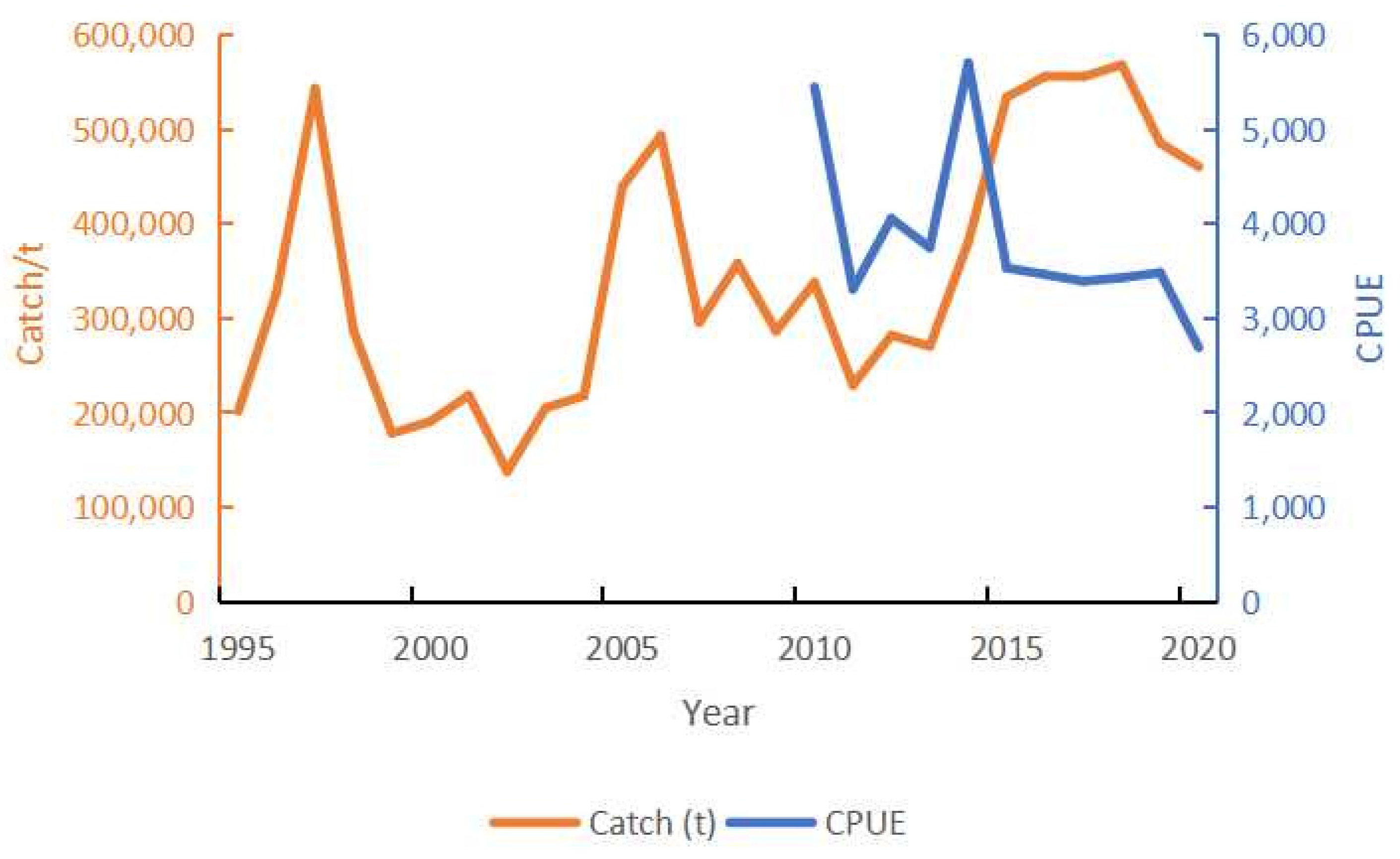
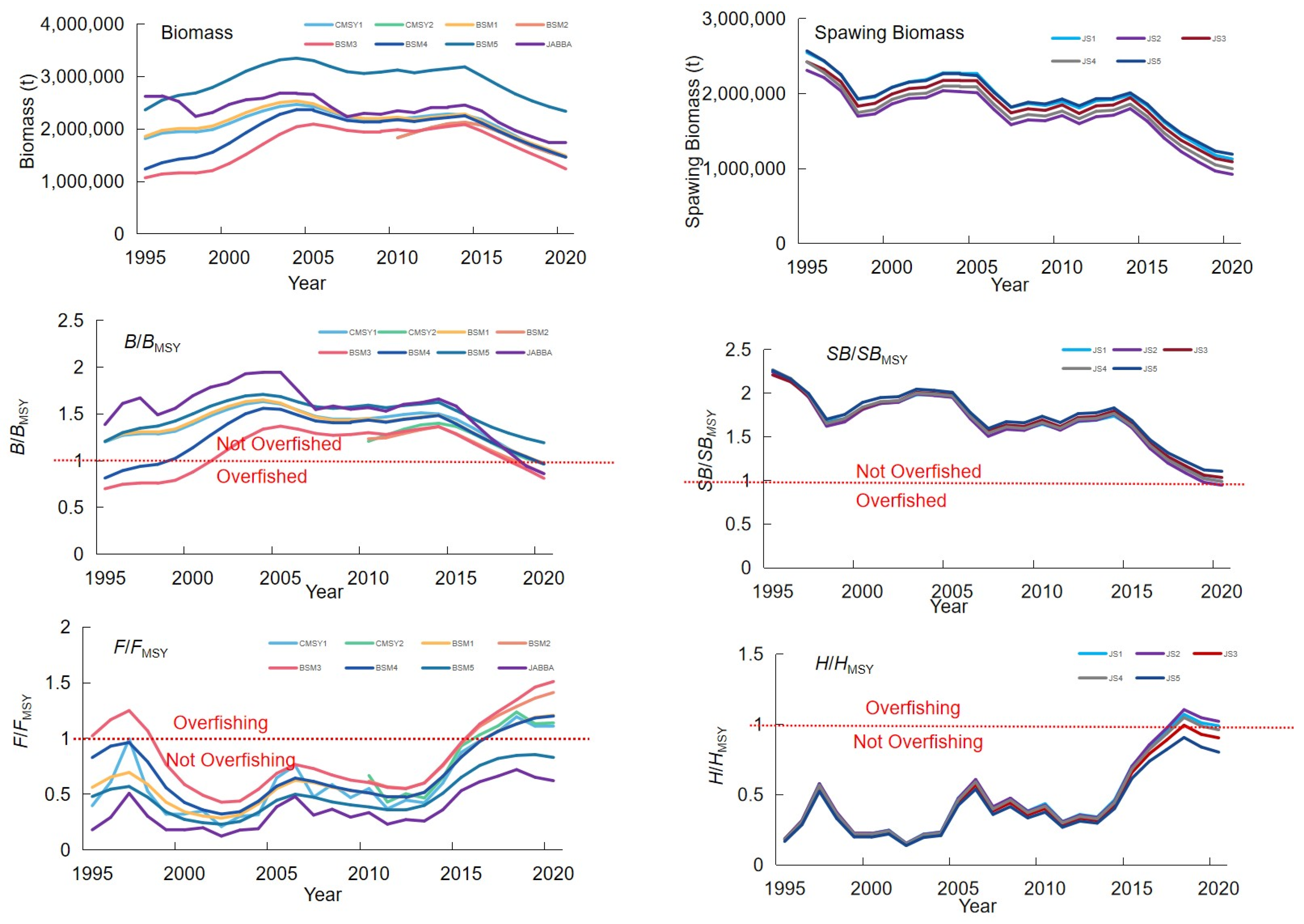
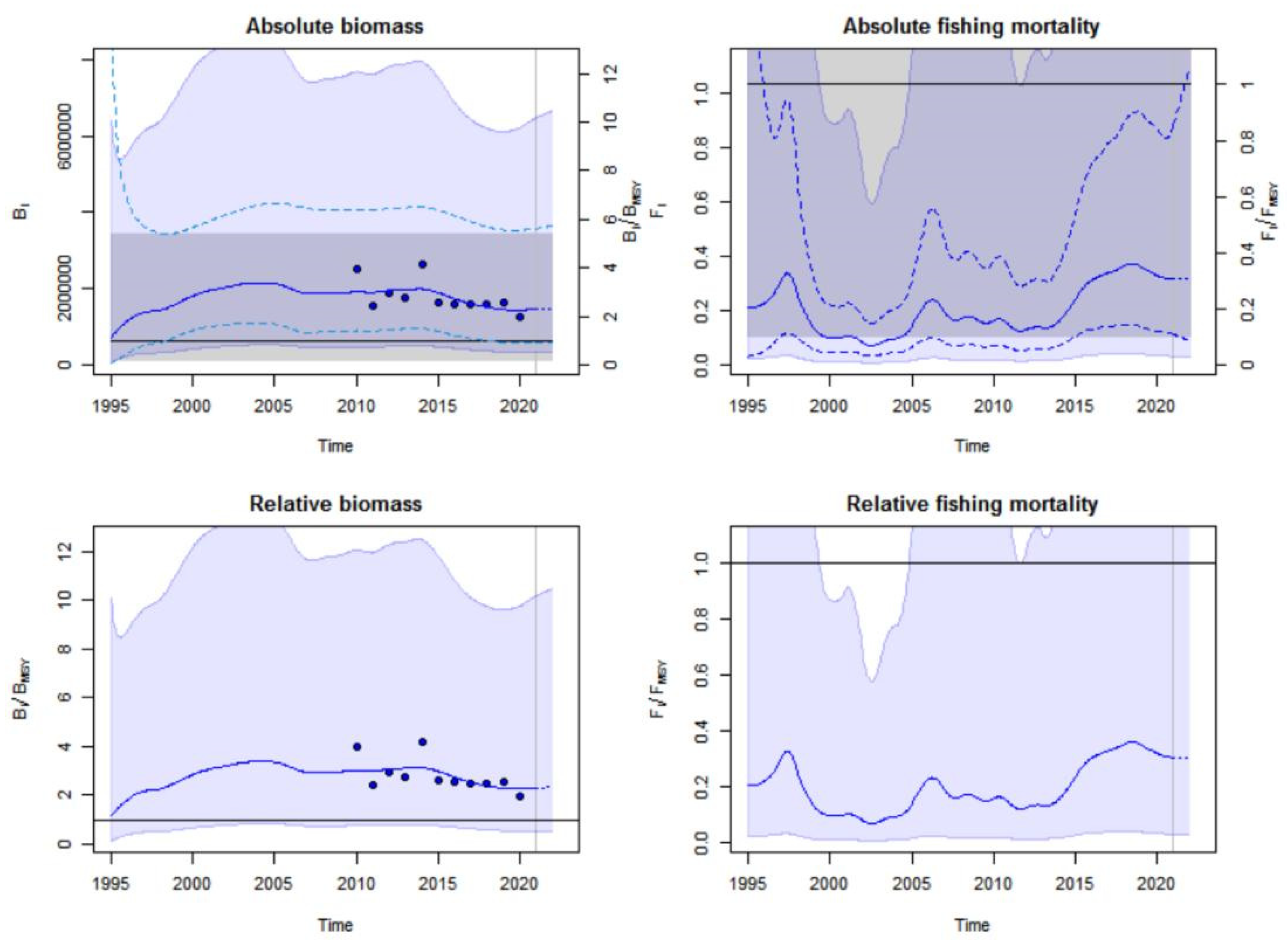
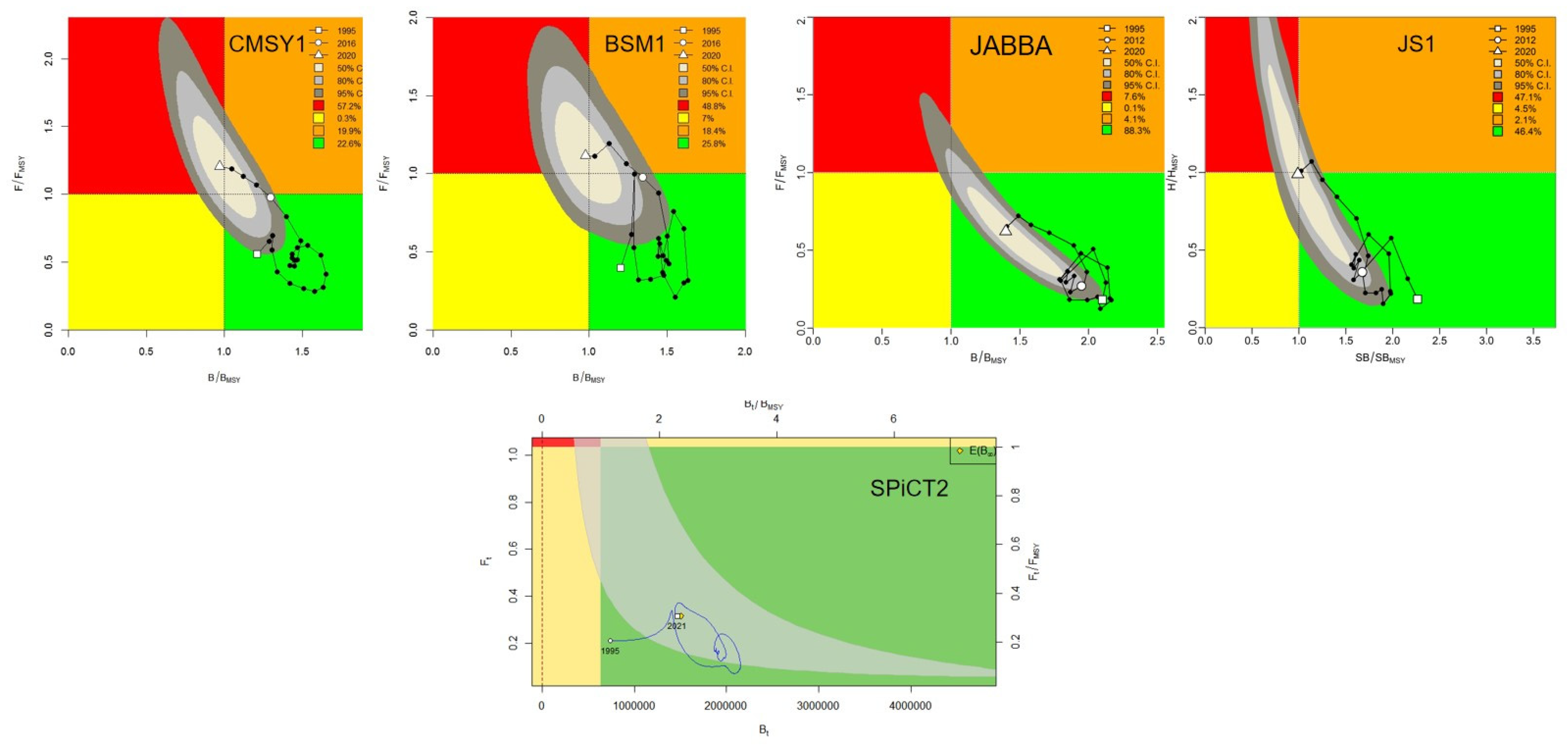
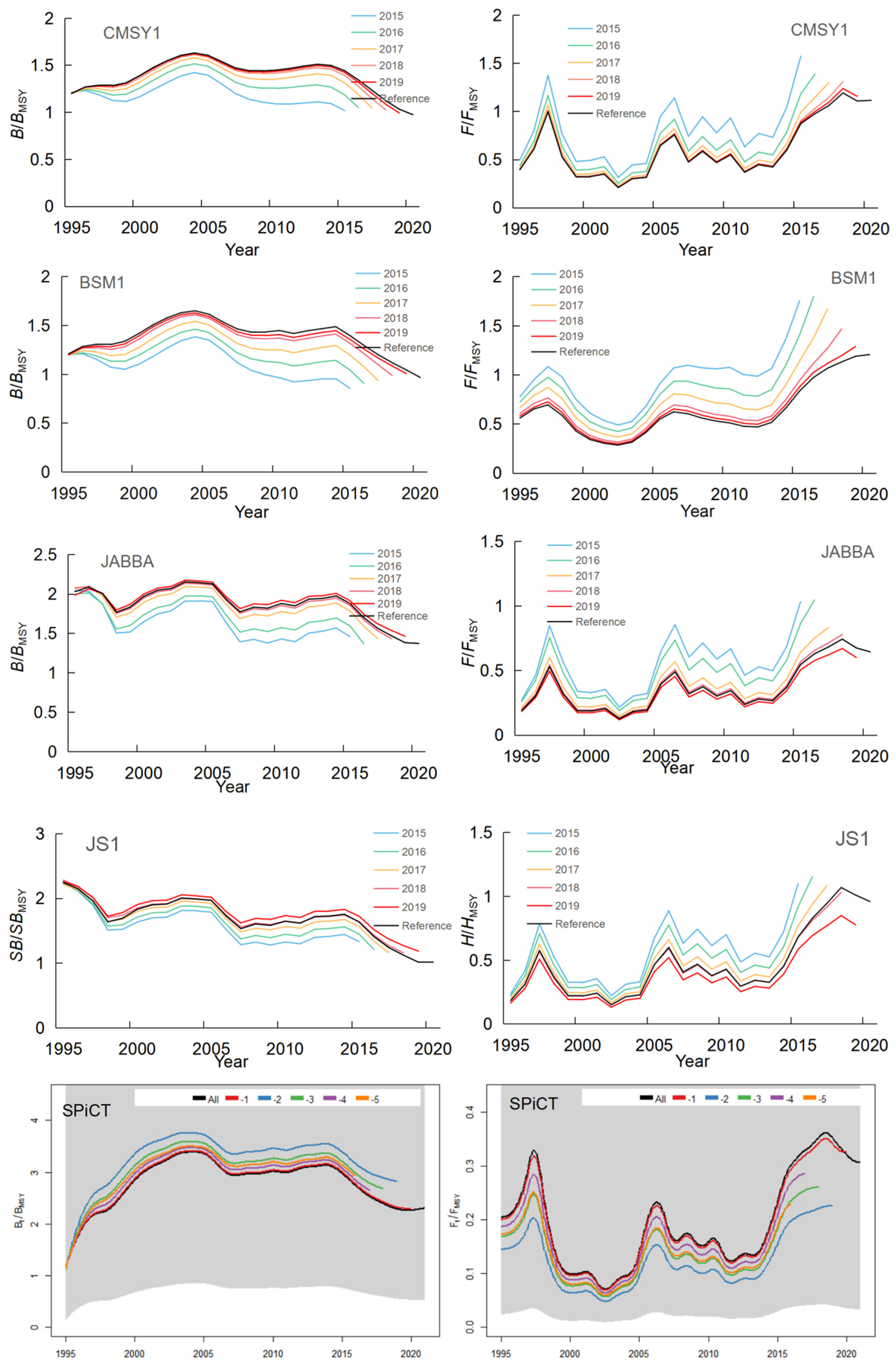
| Scenario | CPUE | Start Year | End Year | r | Start B/K | End B/K |
|---|---|---|---|---|---|---|
| CMSY1 | NO | 1995 | 2020 | (0.32, 0.73) [24] | (0.4, 0.8) [4,23] | (0.2, 0.6) [4,23] |
| CMSY2 | NO | 2010 | 2020 | (0.32, 0.73) [24] | (0.4, 0.8) [4,23] | (0.2, 0.6) [4,23] |
| BSM1 | YES | 1995 | 2020 | (0.32, 0.73) [24] | (0.4, 0.8) [4,23] | (0.2, 0.6) [4,23] |
| BSM2 | YES | 2010 | 2020 | (0.32, 0.73) [24] | (0.4, 0.8) [4,23] | (0.2, 0.6) [4,23] |
| BSM3 | YES | 1995 | 2020 | (0.32, 0.73) [24] | (0.01, 0.4) [23] | (0.01, 0.4) [23] |
| BSM4 | YES | 1995 | 2020 | (0.32, 0.73) [24] | (0.2, 0.6) [23] | (0.2, 0.6) [23] |
| BSM5 | YES | 1995 | 2020 | (0.32, 0.73) [24] | (0.4, 0.8) [23] | (0.4, 0.8) [23] |
| Catch | CPUE | ln(K) | ln(r) | |
|---|---|---|---|---|
| SPiCT1 | 1995–2020 | 2010–2020 | NO | NO |
| SPiCT2 | 1995–2020 | 2010–2020 | N(ln3,400,000, 0.52) [12] | N(ln0.5, 0.52) [24] |
| Catch | CPUE | K | r | m | SB0 | Life History Parameters and Selectivity | |
|---|---|---|---|---|---|---|---|
| JABBA | 1995–2020 | 2010–2020 | U(2Cmax, 10Cmax) [12] | U(0.32, 0.73) [24] | 1.2 [16] | - | - |
| JABBA-Select | 1995–2020 | 2010–2020 | - | - | - | N(3,000,000,0.5) [19] | Table 4 |
| Parameters | Symbol | Values | References |
|---|---|---|---|
| Maximum length (mm) | L∞ | 371 | [5] |
| Growth rate (year−1) | k | 0.39 | [5] |
| Theoretical age at zero-length | t0 | −1.96 | [5] |
| Scaling coefficient for the weight at length (g·mm−3) | a | 3.12 × 10−6 | [20] |
| Shape parameter for the body form | b | 3.23 | [20] |
| Minimum age | tmin | 0 | [5] |
| Maximum age | tmax | 11.1 | [5] |
| Natural mortality | M | 0.41 | [5] |
| Steepness in the spawner recruitment relationship (Beverton–Holt) | h | 0.73 | [4] |
| Length at 50% maturity (mm) | mat50 | 300 | [21] |
| Length at 95% maturity (mm) | mat95 | 350 | [21] |
| Length at 50% selectivity of purse seine (mm) | LPS_50 | 218 | [21] |
| Length at 95% selectivity of purse seine (mm) | LPS_95 | 294 | [21] |
| Scenario | Initial Multiplier | Length at 50% Selectivity of Purse Seine (mm) | Length at 95% Selectivity of Purse Seine (mm) |
|---|---|---|---|
| JS1 | 1 | 218 | 294 |
| JS2 | 0.8 | 174 | 235 |
| JS3 | 0.9 | 196 | 265 |
| JS4 | 1.1 | 240 | 323 |
| JS5 | 1.2 | 262 | 353 |
| MSY (106 t) | K or SB0 (106 t) | r | BMSY or SBMSY (106 t) | FMSY or HMSY | B2020/B0 | B2020/BMSY or SB2020/SBMSY | F2020/FMSY or H2020/HMSY | |
|---|---|---|---|---|---|---|---|---|
| CMSY1 | 0.43 (0.31, 0.59) | 3.02 (2.11, 4.33) | 0.56 (0.41, 0.76) | 1.51 (1.06, 2.17) | 0.28 (0.20, 0.38) | 0.48 (0.34, 0.70) | 0.98 (0.47, 1.19) | 1.12 (0.91, 2.33) |
| CMSY2 | 0.43 (0.30, 0.59) | 3.04 (2.10, 4.40) | 0.55 (0.40, 0.76) | 1.52 (1.05, 2.20) | 0.28 (0.20, 0.38) | 0.48 (0.33, 0.69) | 0.96 (0.45, 1.19) | 1.14 (0.92, 2.43) |
| BSM1 | 0.41 (0.33, 0.52) | 3.07 (2.27, 4.15) | 0.54 (0.37, 0.78) | 1.54 (1.14, 2.07) | 0.27 (0.19, 0.39) | 0.48 (0.36, 0.65) | 0.97 (0.66, 1.27) | 1.21 (0.75, 2.09) |
| BSM2 | 0.40 (0.32, 0.49) | 3.15 (2.28, 4.36) | 0.51 (0.35, 0.74) | 1.58 (1.14, 2.18) | 0.25 (0.17, 0.37) | 0.43 (0.31, 0.60) | 0.86 (0.59, 1.19) | 1.41 (0.85, 2.32) |
| BSM3 | 0.40 (0.33, 0.47) | 3.06 (2.23, 4.19) | 0.52 (0.36, 0.74) | 1.53 (1.11, 2.09) | 0.26 (0.18, 0.37) | 0.41 (0.30, 0.56) | 0.81 (0.57, 0.99) | 1.51 (1.090, 2.34) |
| BSM4 | 0.42 (0.34, 0.52) | 3.04 (2.24, 4.11) | 0.55 (0.38, 0.79) | 1.52 (1.12, 2.06) | 0.28 (0.19, 0.39) | 0.48 (0.36, 0.65) | 0.96 (0.65, 1.27) | 1.20 (0.76, 2.09) |
| BSM5 | 0.49 (0.36, 0.67) | 3.92 (2.75, 5.59) | 0.50 (0.35, 0.72) | 1.96 (1.38, 2.79) | 0.25 (0.18, 0.36) | 0.60 (0.0.42, 0.85) | 1.19 (0.86, 1.52) | 0.83 (0.48, 1.44) |
| SPiCT1 | 0.70 (0.42, 1.17) | 0.37 (0.35, 3.86) | 4.97 (0.33, 74.02) | 0.13 (0.02, 0.75) | 5.32 (1.19, 23.73) | 0.68 | 1.88 (0.94, 3.73) | 0.38 (0, 10.1.41) |
| SPiCT2 | 0.66 (0.29, 1.47) | 2.61 (1.34, 5.13) | 0.49 (0.20, 1.20) | 0.64 (0.12, 3.46) | 2.73 (0.45, 1683) | 0.56 | 2.30 (0.52, 10.15) | 0.31 (0.03, 2.93) |
| JABBA | 0.53 (0.39, 0.87) | 3.14 (2.17, 4.95) | 0.51 (0.35, 0.75) | 1.26 (0.87, 1.98) | 0.43 (0.29, 0.63) | 0.56 (0.34, 0.77) | 1.40 (0.87, 1.92) | 0.62 (0.28, 1.36) |
| JS1 | 0.50 (0.35, 0.98) | 2.88 (1.73, 4.99) | 0.38 (0.22, 0.68) | 0.76 (0.38, 1.53) | 0.68 (0.28, 1.74) | 0.40 (0.20, 0.69) | 0.99 (0.51, 1.72) | 0.99 (0.31, 2.42) |
| JS2 | 0.52 (0.34, 1.20) | 2.63 (1.43, 5.31) | 0.42 (0.21, 0.85) | 0.67 (0.29, 1.56) | 0.83 (0.29, 2.44) | 0.38 (0.15, 0.73) | 0.95 (0.37, 1.83) | 1.02 (0.24, 3.63) |
| JS3 | 0.53 (0.35, 1.20) | 2.79 (1.56, 5.39) | 0.40 (0.22, 0.78) | 0.72 (0.33, 1.51) | 0.77 (0.30, 2.20) | 0.41 (0.20, 0.74) | 1.03 (0.50, 1.86) | 0.90 (0.24, 2.53) |
| JS4 | 0.52 (0.34, 1.10) | 2.67 (1.54, 0.52) | 0.41 (0.20, 0.77) | 0.68 (0.32, 1.55) | 0.81 (0.28, 2.29) | 0.40 (0.16, 0.71) | 0.99 (0.40, 1.77) | 0.96 (0.28, 3.40) |
| JS5 | 0.56 (0.36, 1.18) | 2.84 (1.58, 5.27) | 0.42 (0.02, 0.79) | 0.72 (0.33, 1.52) | 0.81 (0.31, 2.32) | 0.44 (0.21, 0.74) | 1.11 (0.53, 1.84) | 0.80 (0.25, 2.33) |
| CMSY1 | BSM1 | SPiCT2 | JABBA | JS1 | |
|---|---|---|---|---|---|
| Mohn’s ρ values of B/BMSY (or SB/SBMSY in JABBA-Select) | −1.01 | −1.51 | 0.09 | −0.59 | −0.28 |
| Mohn’s ρ values of F/FMSY (or H/HMSY in JABBA-Select) | 1.06 | 1.65 | −0.19 | 0.97 | 0.45 |
Disclaimer/Publisher’s Note: The statements, opinions and data contained in all publications are solely those of the individual author(s) and contributor(s) and not of MDPI and/or the editor(s). MDPI and/or the editor(s) disclaim responsibility for any injury to people or property resulting from any ideas, methods, instructions or products referred to in the content. |
© 2023 by the authors. Licensee MDPI, Basel, Switzerland. This article is an open access article distributed under the terms and conditions of the Creative Commons Attribution (CC BY) license (https://creativecommons.org/licenses/by/4.0/).
Share and Cite
Cai, K.; Kindong, R.; Ma, Q.; Tian, S. Stock Assessment of Chub Mackerel (Scomber japonicus) in the Northwest Pacific Using a Multi-Model Approach. Fishes 2023, 8, 80. https://doi.org/10.3390/fishes8020080
Cai K, Kindong R, Ma Q, Tian S. Stock Assessment of Chub Mackerel (Scomber japonicus) in the Northwest Pacific Using a Multi-Model Approach. Fishes. 2023; 8(2):80. https://doi.org/10.3390/fishes8020080
Chicago/Turabian StyleCai, Kai, Richard Kindong, Qiuyun Ma, and Siquan Tian. 2023. "Stock Assessment of Chub Mackerel (Scomber japonicus) in the Northwest Pacific Using a Multi-Model Approach" Fishes 8, no. 2: 80. https://doi.org/10.3390/fishes8020080
APA StyleCai, K., Kindong, R., Ma, Q., & Tian, S. (2023). Stock Assessment of Chub Mackerel (Scomber japonicus) in the Northwest Pacific Using a Multi-Model Approach. Fishes, 8(2), 80. https://doi.org/10.3390/fishes8020080









